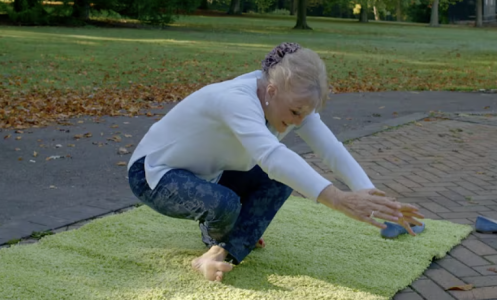How long will you live? This simple at-home test could offer some surprising clues
By
Veronica E.
- Replies 0
Disclaimer: The information provided in this article is for educational purposes only and is not intended as a substitute for professional medical advice, diagnosis, or treatment. Always consult your physician or other qualified healthcare providers with any questions you may have regarding a medical condition or before making any changes to your health regimen.
It’s one of the biggest questions we ask ourselves—how long will we live?
While no one can see the future, researchers are getting closer to identifying indicators that might offer some insight into our longevity.
And here’s the interesting part: one of the most powerful tools doesn’t involve blood tests or DNA swabs.
Instead, all it takes is a bit of space on your floor—and the willingness to give something a little challenging a try.
It’s called the sitting-to-rising test, and it might reveal more about your long-term health than you expect.

Picture this: you’re standing tall.
Now, without using your hands, knees, or arms for support, lower yourself into a cross-legged seated position on the floor.
Once you’re down, stand back up—again, without using anything for help.
Sounds easy? It’s trickier than it looks.
The test measures what experts call non-aerobic fitness—your balance, flexibility, muscle strength, and coordination.
These abilities are especially important as we age, helping us stay independent and reducing the risk of falls or injury.
And according to a major study from Brazil, how you perform on this test might be tied to how long you live.
The study, published in the European Journal of Preventive Cardiology, followed more than 4,200 adults aged 46 to 75 over a 12-year period.
Each participant took the sitting-to-rising test and received a score between 0 and 10—five points for sitting down, and five for standing up.
Points were deducted if they used a hand, knee, elbow, or lost their balance.
The results were eye-opening.
Those who scored higher were significantly more likely to still be alive at the end of the 12 years.
In fact, most of the top scorers were still going strong, while fewer than half of those with the lowest scores had survived.
Even people with heart disease were more likely to live longer if they scored well on the test.
It’s a powerful reminder that our ability to move our own bodies with strength and control matters—a lot.
We often hear about the importance of cardio—like walking, swimming, or cycling.
But according to the study’s lead author, Dr. Claudio Gil Araújo, we also need to pay attention to muscle strength, flexibility, and balance.
These abilities help us stay on our feet, avoid injuries, and maintain the independence we cherish as we get older.
The sitting-to-rising test offers a quick and simple way to check in on those aspects of your fitness.
And the best part? It’s not a pass/fail test.
If you struggle today, you can work on improving—and improve your score (and overall health) over time.
The sitting-to-rising test is just one tool in the toolbox. Here are a few other easy ways to check in on your fitness and functional health—no equipment required:
These tests, when taken together, give a more complete picture of your physical health—and may even help predict your longevity.
If the sitting-to-rising test felt like more of a challenge than you expected, don’t be discouraged. With some regular movement and the right exercises, improvement is absolutely possible:
And remember, it’s never too late to start.
Just a few minutes a day can have a big impact over time!
If getting down to the floor or back up feels unsafe, don’t push it.
Use a chair or ask someone to help you as a spotter.
And if you have any health concerns or medical conditions, talk with your doctor before starting a new fitness routine.
Safety always comes first!
Read next: This simple blood test could save your life–90% accurate in detecting colon cancer

Have you tried the sitting-to-rising test yet? How did it go? What are your favorite ways to stay strong, flexible, and balanced?
We’d love to hear your thoughts, tips, or questions in the comments. Here at The GrayVine, we believe in aging with purpose, strength, and a good sense of humor. Let’s support each other—and keep moving forward, one strong step at a time!
It’s one of the biggest questions we ask ourselves—how long will we live?
While no one can see the future, researchers are getting closer to identifying indicators that might offer some insight into our longevity.
And here’s the interesting part: one of the most powerful tools doesn’t involve blood tests or DNA swabs.
Instead, all it takes is a bit of space on your floor—and the willingness to give something a little challenging a try.
It’s called the sitting-to-rising test, and it might reveal more about your long-term health than you expect.

Everyday movements like sitting and standing can offer surprising insight into your overall health and well-being. Image Source: YouTube / BBC.
What is the sitting-to-rising test?
Picture this: you’re standing tall.
Now, without using your hands, knees, or arms for support, lower yourself into a cross-legged seated position on the floor.
Once you’re down, stand back up—again, without using anything for help.
Sounds easy? It’s trickier than it looks.
The test measures what experts call non-aerobic fitness—your balance, flexibility, muscle strength, and coordination.
These abilities are especially important as we age, helping us stay independent and reducing the risk of falls or injury.
And according to a major study from Brazil, how you perform on this test might be tied to how long you live.
Also read: This simple thumb test could reveal a hidden heart problem—are you at risk?
What the research shows
The study, published in the European Journal of Preventive Cardiology, followed more than 4,200 adults aged 46 to 75 over a 12-year period.
Each participant took the sitting-to-rising test and received a score between 0 and 10—five points for sitting down, and five for standing up.
Points were deducted if they used a hand, knee, elbow, or lost their balance.
The results were eye-opening.
Those who scored higher were significantly more likely to still be alive at the end of the 12 years.
In fact, most of the top scorers were still going strong, while fewer than half of those with the lowest scores had survived.
Even people with heart disease were more likely to live longer if they scored well on the test.
It’s a powerful reminder that our ability to move our own bodies with strength and control matters—a lot.
Also read: Could this overlooked blood test help catch cancer early? Here’s what doctors want you to know
Why this matters for healthy aging
We often hear about the importance of cardio—like walking, swimming, or cycling.
But according to the study’s lead author, Dr. Claudio Gil Araújo, we also need to pay attention to muscle strength, flexibility, and balance.
These abilities help us stay on our feet, avoid injuries, and maintain the independence we cherish as we get older.
The sitting-to-rising test offers a quick and simple way to check in on those aspects of your fitness.
And the best part? It’s not a pass/fail test.
If you struggle today, you can work on improving—and improve your score (and overall health) over time.
Also read: Unlock the secret early detector of Alzheimer’s: This simple DIY test could reveal clues in advance!
More simple tests you can try at home
The sitting-to-rising test is just one tool in the toolbox. Here are a few other easy ways to check in on your fitness and functional health—no equipment required:
- The One-Leg Stand: Try balancing on one foot for 10 seconds. Research shows that those who can’t do this are nearly twice as likely to die in the next 10 years compared to those who can.
- The Six-Minute Walk: See how far you can walk at a comfortable pace in six minutes. This test is often used in clinics to assess heart and lung health.
- The Chair Stand Test: Sit in a chair and stand up five times in 30 seconds without using your hands. This checks your lower body strength and endurance.
These tests, when taken together, give a more complete picture of your physical health—and may even help predict your longevity.
How to improve your score (and your long-term health)
If the sitting-to-rising test felt like more of a challenge than you expected, don’t be discouraged. With some regular movement and the right exercises, improvement is absolutely possible:
- Strength training: Lifting light weights or using resistance bands builds key muscle groups that help with standing and sitting.
- Balance exercises: Try simple practices like standing on one foot, heel-to-toe walking, or beginner yoga routines.
- Flexibility work: Stretching, tai chi, or gentle yoga can help improve joint mobility and prevent stiffness.
And remember, it’s never too late to start.
Just a few minutes a day can have a big impact over time!
A quick word of caution
If getting down to the floor or back up feels unsafe, don’t push it.
Use a chair or ask someone to help you as a spotter.
And if you have any health concerns or medical conditions, talk with your doctor before starting a new fitness routine.
Safety always comes first!
Read next: This simple blood test could save your life–90% accurate in detecting colon cancer
Key Takeaways
- A Brazilian study found that the sitting-to-rising test, which assesses balance, muscle strength, and flexibility, may help predict longevity—participants with higher scores lived longer over a 12-year follow-up.
- People who could sit down and rise without using hands, knees, or other supports were more likely to survive, even among those with existing health conditions like heart disease.
- While not a direct measure of lifespan, the test offers valuable insight into non-aerobic fitness, helping spark important conversations about healthy aging and independence.
- Other at-home tests—such as the one-leg stand, six-minute walk, and chair stand test—can also provide useful information about overall physical health and risk factors.
Have you tried the sitting-to-rising test yet? How did it go? What are your favorite ways to stay strong, flexible, and balanced?
We’d love to hear your thoughts, tips, or questions in the comments. Here at The GrayVine, we believe in aging with purpose, strength, and a good sense of humor. Let’s support each other—and keep moving forward, one strong step at a time!






